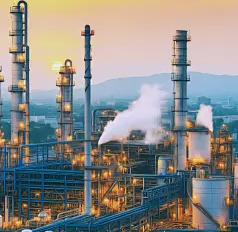Jun 25, 2025
In the complex network of industrial production and the tight defense line of environmental protection, hydrogen cyanide (HCN) is a highly threatening substance, and its monitoring and prevention are crucial. Hydrogen cyanide is a colorless but highly toxic gas with a bitter almond odor. It is volatile and can mix evenly with air. At specific concentrations, it is also flammable and explosive. Whether in chemical manufacturing, metal processing, or other industries involving the use of cyanide, a slight mistake can lead to a serious safety accident caused by the leakage of hydrogen cyanide, endangering life and damaging the environment. And hydrogen cyanide sensors are the key defense line against this threat, playing an irreplaceable role in safeguarding safety and protecting the environment.
一、 Working principle of hydrogen cyanide sensor
The core working mechanism of hydrogen cyanide sensors is mainly based on electrochemical principles, often using a three electrode design, consisting of a working electrode, a counter electrode, a reference electrode, and a liquid electrolyte to form a precise detection system. When hydrogen cyanide gas in the environment enters the sensor through diffusion holes and reaches the surface of the working electrode, a wonderful chemical reaction begins. Hydrogen cyanide undergoes electrochemical reduction reaction on the working electrode, and the protons generated during the reaction will migrate to the counter electrode through the polymer electrolyte. This charge transfer process forms a current signal. According to the first Fick's law, the magnitude of the current is directly proportional to the concentration of the measured hydrogen cyanide gas. The reference electrode works in conjunction with the potentiostat to maintain a constant potential, ensuring the stability and accuracy of the entire detection process. In this way, the sensor can accurately convert the concentration information of hydrogen cyanide into measurable and analyzable electrical signals, providing a basis for subsequent concentration calculations and alarm triggering.
二、 Excellent characteristics of hydrogen cyanide sensor
(1) High sensitivity and fast response
The hydrogen cyanide sensor can be called a "keen hunter", capable of detecting extremely small amounts of hydrogen cyanide gas. The detection limit of some high-performance sensors can reach 0.01 ppm. Once there is even a tiny change in the concentration of hydrogen cyanide, the sensor can respond quickly, sensing within just 3 seconds and reaching a response level of 90% within 30 seconds (T90<30 seconds). This high sensitivity and fast response feature enables timely capture of danger signals in the early stages of hydrogen cyanide leakage, saving valuable time for personnel evacuation and emergency response, greatly reducing the possibility of safety accidents.
(2) Strong stability
Whether it's high temperatures, scorching heat, low temperatures, or extreme cold, and regardless of changes in environmental humidity or the presence of other interfering gases, the hydrogen cyanide sensor can "stick to its post" and operate stably. It adopts non consumable solid electrolyte technology, which ensures the long-term reliability of detection data with minimal sensitivity attenuation during long-term use. The application of special catalytic electrode preparation technology further enhances the anti-interference ability of the sensor, enabling it to accurately distinguish hydrogen cyanide from other gases, effectively avoiding false alarms and omissions caused by interference, and providing continuous, stable, and accurate data support for industrial production and environmental monitoring.
(3) Wide detection range
The detection range of hydrogen cyanide sensors is very wide, which can detect low concentrations of hydrogen cyanide and meet the strict requirements for monitoring trace amounts of hydrogen cyanide in the environment; It can also work continuously in high concentration hydrogen cyanide gas environments, such as in the event of sudden leaks in certain industrial production processes leading to the release of high concentration hydrogen cyanide. It can also be monitored stably and will not "strike" due to high concentration, providing comprehensive protection for hydrogen cyanide monitoring needs in different scenarios.
三、 Diversified application scenarios of hydrogen cyanide sensors
(1) The guardian deity of safety production in the chemical industry
In the chemical industry, hydrogen cyanide is widely used in the synthesis process of basic chemical raw materials such as acrylonitrile and methyl acrylate, as well as processes such as electroplating and metal extraction. In these production scenarios, hydrogen cyanide sensors act as tireless "safety guards", monitoring the concentration of hydrogen cyanide in key areas such as reaction vessels, pipelines, and storage tanks in real-time 24 hours a day. Once there is an abnormal increase in concentration, even if it is only a slight exceedance, the sensor will immediately transmit the signal to the control system, trigger the sound and light alarm device, remind the staff to promptly investigate the leakage source, take emergency measures, prevent the leakage range from expanding, avoid major safety accidents such as poisoning, fire, explosion caused by hydrogen cyanide leakage, and ensure the smooth and safe operation of chemical production.
(2) The 'Scout' for Fire Emergency Rescue
In fire scenes or other emergency rescue scenarios, the presence of hydrogen cyanide is often a hidden 'killer'. Many nitrogen-containing and carbon containing substances produce hydrogen cyanide during combustion, especially in some industrial and building fires, and its harm should not be underestimated. Firefighters use portable hydrogen cyanide sensors as their "eyes" when entering hazardous areas to carry out tasks. The high-precision and fast response characteristics of sensors can help firefighters detect the presence and concentration level of hydrogen cyanide in complex, harsh, and unknown hazardous environments at the first time, enabling them to make quick judgments, adjust rescue strategies reasonably, wear effective protective equipment in a timely manner, ensure their own safety, and provide important basis for the smooth implementation of rescue operations, improve rescue efficiency, and reduce rescue risks.
(3) The 'outpost' of environmental monitoring
Hydrogen cyanide, as an atmospheric pollutant, has a profound impact on the ecological environment and public health from its emissions. In the field of environmental protection, hydrogen cyanide sensors are widely deployed in key locations such as industrial concentration areas, sewage treatment plants, landfill sites, and urban air quality monitoring points. By monitoring the concentration of hydrogen cyanide in the ambient air in real-time, sensors can promptly detect whether industrial enterprises have violated emission regulations, as well as changes in the background concentration of hydrogen cyanide in the environment. Once the monitoring data exceeds the national environmental air quality standards (such as China's maximum allowable concentration of hydrogen cyanide in the air of 0.3mg/m ³, about 0.27PPM), the environmental protection department can quickly intervene, take measures to order enterprises to rectify, or control polluted areas, protect the atmospheric environment, safeguard public respiratory safety, and maintain the balance and stability of the ecosystem.
(4) The 'safety shield' for laboratories and research institutions
In research laboratories, hydrogen cyanide is often used for the synthesis of antibiotics, anticancer drugs, and other pharmaceutical research and development, as well as for the production of photoresist, liquid crystal materials, and other electronic research. These experiments often involve high-risk operations and have extremely high safety requirements for the use and storage of hydrogen cyanide. The hydrogen cyanide sensor is installed in key locations such as fume hoods and reagent storage areas in the laboratory to constantly monitor the leakage of hydrogen cyanide. Once a leak occurs, the sensor immediately sounds an alarm, reminding the experimenters to take emergency measures such as shutting off the gas source, strengthening ventilation, evacuating personnel, etc., to avoid harm to experimenters caused by hydrogen cyanide leakage, protect the laboratory's research environment and precious experimental data, and ensure that scientific research work can be carried out in an orderly manner under safe conditions.
四、 The development trend of hydrogen cyanide sensors
With the rapid development of technology and the increasing demand for safety and environmental protection in various industries, hydrogen cyanide sensor technology is also constantly innovating and advancing. On the one hand, we continue to break through in detection accuracy and move towards lower concentration detection limits to meet the demand for monitoring trace amounts of hydrogen cyanide in the environment; At the same time, it further enhances the stability and reliability of the sensor, reducing errors and drift during long-term use. On the other hand, intelligence and networking have become important development directions. Sensors will have stronger data processing and analysis capabilities, capable of automatic data calibration, fault diagnosis, and remote real-time monitoring, data transmission, and sharing through IoT technology, making it convenient for management personnel to grasp hydrogen cyanide concentration information anytime and anywhere, achieving intelligent warning and decision-making. In addition, new materials and manufacturing processes will continue to be applied in the research and development of sensors to cope with complex environmental interference, further enhancing their anti-interference performance and enabling them to work stably even in extreme environments, providing a more comprehensive and reliable guarantee for hydrogen cyanide monitoring.
As an important tool for safeguarding industrial safety and environmental health, hydrogen cyanide sensors play an irreplaceable role in ensuring personnel safety, promoting sustainable industrial development, and maintaining ecological balance, thanks to their unique working principle, excellent performance characteristics, and wide application scenarios. With the continuous advancement and improvement of technology, we believe that hydrogen cyanide sensors will shine brighter in the fields of safety and environmental protection in the future, building a solid safety defense line for our production and life.
Read More











